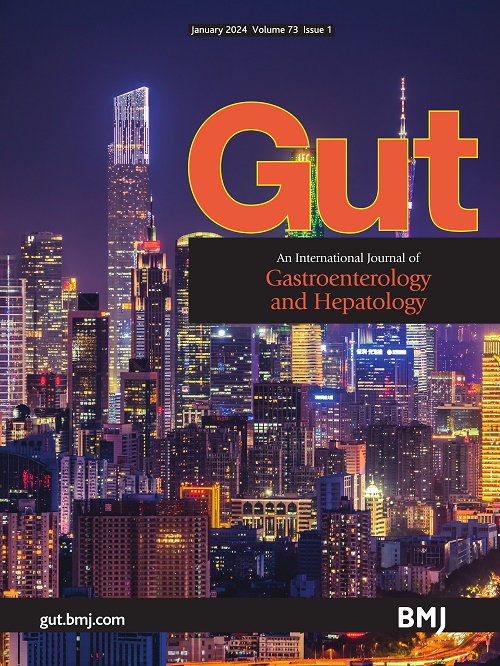Cck2r+体祖细胞的胃泌素依赖性扩张加速溃疡愈合并抑制胃发育不良
IF 25.8
1区 医学
Q1 GASTROENTEROLOGY & HEPATOLOGY
引用次数: 0
摘要
胆囊收缩素-2/胃泌素受体(Cck2r)在体峡祖细胞、肠嗜铬样细胞和壁细胞中表达,调节酸分泌和细胞更新。然而,胃泌素在粘膜再生过程中对Cck2r祖细胞的作用仍未被探索。目的探讨胃泌素- cck2r轴和原体祖细胞在胃损伤和再生中的作用。我们生成Cck2r-CreERT2;Gastrin-DTR-p2A-TdTomato;在低胃酸血症和高胃酸血症条件下,Rosa26-ZsGreen小鼠在稳态和损伤期间追踪Cck2r+祖细胞。损伤模型包括急性溃疡、慢性幽门螺杆菌胃炎和n -亚硝基- n -甲基脲(MNU)暴露。结果高胃血症显著扩增了Cck2r+峡部祖细胞,而低胃血症则使其减少。胃溃疡在第14天引起血浆胃泌素的两倍升高,在第28天引起胃窦g细胞扩增和溃疡完全愈合。胃泌素输注或质子泵抑制剂(PPI)治疗可进一步提高胃泌素水平,并在第14天促进溃疡完全愈合,而g细胞消融可减少胃泌素,损害愈合,并消除PPI的益处(p < 0.05)。在溃疡愈合过程中,迷走神经通过毒蕈碱受体3介导胃泌素升高和Cck2r+祖细胞扩增。幽门螺杆菌感染小鼠的g细胞消融增加了定植,加重了炎症、萎缩、化生和不典型增生(p < 0.05),而高胃酸血症具有保护作用。同样,在MNU模型中,g细胞消融加重了胃病理,而高胃血症则减轻了胃病理。我们报道了g细胞源性胃泌素在溃疡愈合中的新作用。低胃泌素血症是溃疡愈合不良、体萎缩和潜在癌症的危险因素,而生理性胃泌素反应具有保护作用。ppi诱导的高胃泌素血症在溃疡愈合中起关键作用,胃泌素信号传导可能预防胃瘤前病变。所有与研究相关的数据都包含在文章中或作为补充信息上传。本文章由计算机程序翻译,如有差异,请以英文原文为准。
Gastrin-dependent expansion of Cck2r+ corpus progenitors accelerates ulcer healing and inhibits gastric dysplasia
Background The cholecystokinin-2/gastrin receptor (Cck2r) is expressed in corpus isthmus progenitor, enterochromaffin-like and parietal cells, regulating acid secretion and cell turnover. However, the role of gastrin on Cck2r progenitors during mucosal regeneration remains unexplored. Objective To study the role of gastrin-Cck2r axis and corpus progenitors during gastric injury and regeneration. Design We generated Cck2r-CreERT2; Gastrin-DTR-p2A-TdTomato; Rosa26-ZsGreen mice to trace corpus Cck2r+ progenitors during homeostasis and injury, under conditions of hypogastrinaemia and hypergastrinaemia. Injury models included acute ulceration, chronic H. pylori gastritis and N-Nitroso-N-Methylurea (MNU) exposure. Results Hypergastrinaemia significantly expanded Cck2r+ isthmus progenitors, whereas hypogastrinaemia reduced them. Gastric ulceration induced a twofold elevation in plasma gastrin by day 14, antral G-cell expansion and complete ulcer healing by day 28. Gastrin infusion or proton pump inhibitor (PPI) treatment further elevated gastrin and promoted complete ulcer healing by day 14, whereas G-cell ablation minimised gastrin, impaired healing and abrogated the benefits of PPI (p < 0.05). The vagus nerve, through the muscarinic receptor 3, mediated both gastrin elevations and Cck2r+ progenitor expansion during ulcer healing. G-cell ablation in H. pylori -infected mice increased colonisation and exacerbated inflammation, atrophy, metaplasia and dysplasia (p < 0.05), while hypergastrinaemia was protective. Similarly, in the MNU model, G-cell ablation worsened gastric pathology while hypergastrinaemia mitigated it. Conclusions We report a novel role for G-cell-derived gastrin in ulcer healing. Hypogastrinaemia is a risk factor for poor ulcer healing, corpus atrophy and potentially cancer, while physiological gastrin responses are protective. PPI-induced hypergastrinaemia plays a key role in ulcer healing, and gastrin signalling may prevent gastric preneoplasia. All data relevant to the study are included in the article or uploaded as supplementary information.
求助全文
通过发布文献求助,成功后即可免费获取论文全文。
去求助
来源期刊

Gut
医学-胃肠肝病学
CiteScore
45.70
自引率
2.40%
发文量
284
审稿时长
1.5 months
期刊介绍:
Gut is a renowned international journal specializing in gastroenterology and hepatology, known for its high-quality clinical research covering the alimentary tract, liver, biliary tree, and pancreas. It offers authoritative and current coverage across all aspects of gastroenterology and hepatology, featuring articles on emerging disease mechanisms and innovative diagnostic and therapeutic approaches authored by leading experts.
As the flagship journal of BMJ's gastroenterology portfolio, Gut is accompanied by two companion journals: Frontline Gastroenterology, focusing on education and practice-oriented papers, and BMJ Open Gastroenterology for open access original research.
 求助内容:
求助内容: 应助结果提醒方式:
应助结果提醒方式:


